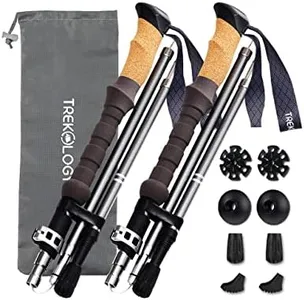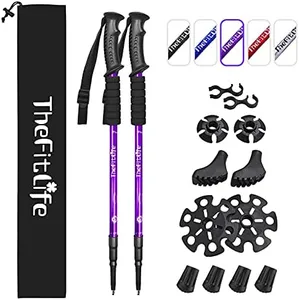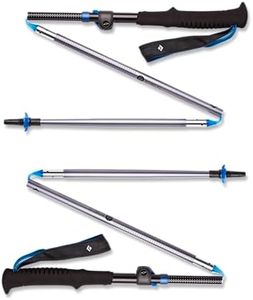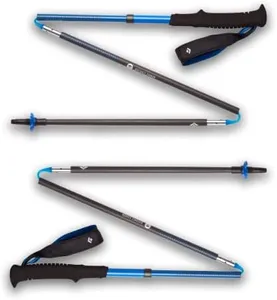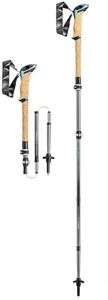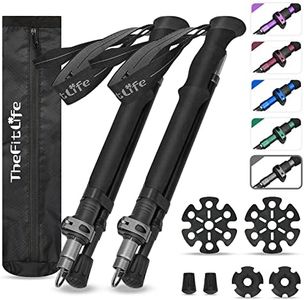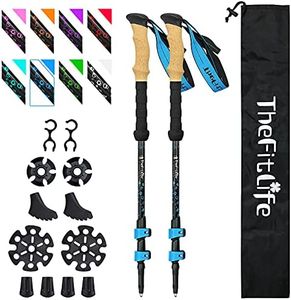We Use CookiesWe use cookies to enhance the security, performance,
functionality and for analytical and promotional activities. By continuing to browse this site you
are agreeing to our privacy policy
10 Best Walking Poles
From leading brands and best sellers available on the web.Buying Guide for the Best Walking Poles
Choosing the right walking poles can greatly enhance your comfort, stability, and efficiency while hiking or walking. The right poles can help you navigate diverse terrains, reduce the strain on your joints, and maintain a steady rhythm. When shopping for walking poles, consider their main features and how they match your intended use, your body size, and the environments you plan to explore. Focusing on specific aspects will help you find poles that best fit your needs and make your outdoor adventures more enjoyable.MaterialThe material of the pole influences its weight, strength, and durability. Most walking poles are made from either aluminum or carbon fiber. Aluminum poles are known for their durability and are less prone to snapping under heavy loads, making them a good choice for challenging terrain or heavier users. Carbon fiber poles are much lighter but can be more expensive and are more likely to break if they experience sudden impacts. If you prioritize lightweight gear for long distances or fast hiking, carbon may be best. If you value ruggedness or anticipate rough handling, aluminum might be a better fit.
AdjustabilityAdjustability refers to whether the length of the poles can be changed. Some poles are fixed-length, while others are adjustable or even foldable. Adjustable poles let you set the height to suit your body or the terrain, such as shortening them for uphill sections and lengthening for downhills. Foldable poles are more compact for packing. If you frequently hike on varied terrain, or want to share your poles with others, adjustability is very useful. If you're a walker who mainly stays on predictable paths, fixed-length poles may offer simplicity and slightly less weight.
Locking MechanismThe locking mechanism secures adjustable poles at the desired length. Common types include twist locks, lever locks, and push-button locks. Lever locks are usually faster and easier to operate, even with cold or gloved hands, though twist locks can offer a cleaner look and are less likely to get caught on things. Push-button locks are often found on foldable styles. If you want quick, easy adjustments, look for lever or push-button types. For infrequent adjustments or a more streamlined design, twist locks can suffice.
Grip MaterialGrip material affects your comfort and how well the pole handles sweat or wet weather. The main options are cork, foam, and rubber. Cork grips conform to your hand over time and wick away moisture, making them suitable for long, sweaty hikes. Foam grips are soft and absorbent but may not last as long, while rubber provides good insulation and grip, especially in cold or rainy conditions. Your choice should reflect your typical climate and what feels best in your hand; try different types if possible to see what suits you.
WeightThe weight of the poles can influence how easy they are to use over long distances. Lighter poles reduce arm fatigue but may not be as sturdy, while heavier poles usually mean increased durability and stability. If you're planning long treks or care about overall trail efficiency, lighter poles are preferable. For shorter hikes or where strength is more important, a bit of extra weight can be beneficial.
Shock AbsorptionSome walking poles include shock-absorbing features, usually in the form of built-in springs. These can reduce impact on joints, especially during downhill sections. However, shock absorbers can add weight and may not be necessary for everyone. If you have sensitive joints or plan to descend steep trails often, look for shock absorption. Otherwise, standard poles may feel lighter and more direct.
Basket and Tip TypeThe basket and tip determine how the poles interact with the ground. Baskets are the circular disks near the tip; small baskets work on dirt trails, while wider ones help on snow or soft ground. Tips are usually carbide for durability, but rubber tips can cover them for urban use. Choose baskets and tips according to where you most often walk: use basic baskets and carbide tips for typical hiking, larger baskets for snow, and rubber covers if you’re mainly on pavement.
